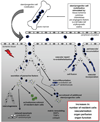Role of endothelial progenitor cells during ischemia-induced vasculogenesis and collateral formation
- PMID: 20144623
- PMCID: PMC2858691
- DOI: 10.1016/j.mvr.2010.01.012
Role of endothelial progenitor cells during ischemia-induced vasculogenesis and collateral formation
Abstract
Cell-based therapy has emerged as a promising therapeutic tool for treatment of ischemic cardiovascular disease. Both unselected bone marrow-derived mononuclear cells (BMNCs), which include stem/progenitor cells and several other cell types, and endothelial progenitor cells (EPCs), a subpopulation of BMNCs, display regenerative potential in ischemic tissue. Abundant evidence supports the involvement of EPCs in capillary growth, and EPCs also appear to participate in the formation of collateral vessels. Collectively, these effects have led to improved perfusion and functional recovery in animal models of myocardial and peripheral ischemia, and in early clinical trials, the therapeutic administration of EPCs to patients with myocardial infarction or chronic angina has been associated with positive trends in perfusion. EPCs also contribute to endothelial repair and may, consequently, impede the development or progression of arteriosclerosis. This review provides a brief summary of the preclinical and clinical evidence for the role of EPCs in blood-vessel formation and repair during ischemic cardiovascular disease.
Copyright 2010 Elsevier Inc. All rights reserved.
Figures


Similar articles
-
Far infra-red therapy promotes ischemia-induced angiogenesis in diabetic mice and restores high glucose-suppressed endothelial progenitor cell functions.Cardiovasc Diabetol. 2012 Aug 15;11:99. doi: 10.1186/1475-2840-11-99. Cardiovasc Diabetol. 2012. PMID: 22894755 Free PMC article.
-
Endothelial precursors in vascular repair.Microvasc Res. 2010 May;79(3):193-9. doi: 10.1016/j.mvr.2010.02.009. Epub 2010 Feb 22. Microvasc Res. 2010. PMID: 20184904 Review.
-
Combination of stromal-derived factor-1alpha and vascular endothelial growth factor gene-modified endothelial progenitor cells is more effective for ischemic neovascularization.J Vasc Surg. 2009 Sep;50(3):608-16. doi: 10.1016/j.jvs.2009.05.049. Epub 2009 Jul 12. J Vasc Surg. 2009. PMID: 19595531
-
Impaired therapeutic vasculogenesis by transplantation of OxLDL-treated endothelial progenitor cells.J Lipid Res. 2007 Mar;48(3):518-27. doi: 10.1194/jlr.M600251-JLR200. Epub 2006 Dec 24. J Lipid Res. 2007. PMID: 17186950
-
Biologic properties of endothelial progenitor cells and their potential for cell therapy.Prog Cardiovasc Dis. 2007 May-Jun;49(6):421-9. doi: 10.1016/j.pcad.2007.02.004. Prog Cardiovasc Dis. 2007. PMID: 17498522 Free PMC article. Review.
Cited by
-
Human endothelial progenitor cells.Cold Spring Harb Perspect Med. 2012 Jul;2(7):a006692. doi: 10.1101/cshperspect.a006692. Cold Spring Harb Perspect Med. 2012. PMID: 22762017 Free PMC article. Review.
-
Identification of the Key Genes Involved in the Effect of Folic Acid on Endothelial Progenitor Cell Transcriptome of Patients with Type 1 Diabetes.Comput Math Methods Med. 2020 Sep 24;2020:4542689. doi: 10.1155/2020/4542689. eCollection 2020. Comput Math Methods Med. 2020. PMID: 33029194 Free PMC article.
-
Perinatal Brain Injury As a Consequence of Preterm Birth and Intrauterine Inflammation: Designing Targeted Stem Cell Therapies.Front Neurosci. 2017 Apr 10;11:200. doi: 10.3389/fnins.2017.00200. eCollection 2017. Front Neurosci. 2017. PMID: 28442989 Free PMC article. Review.
-
Soluble epoxide hydrolase regulates hematopoietic progenitor cell function via generation of fatty acid diols.Proc Natl Acad Sci U S A. 2012 Jun 19;109(25):9995-10000. doi: 10.1073/pnas.1206493109. Epub 2012 Jun 4. Proc Natl Acad Sci U S A. 2012. PMID: 22665795 Free PMC article.
-
De-novo collateral formation following acute myocardial infarction: Dependence on CCR2⁺ bone marrow cells.J Mol Cell Cardiol. 2015 Oct;87:4-16. doi: 10.1016/j.yjmcc.2015.07.020. Epub 2015 Aug 4. J Mol Cell Cardiol. 2015. PMID: 26254180 Free PMC article.
References
-
- Asahara T, Murohara T, Sullivan A, Silver M, van der Zee R, Li T, Witzenbichler B, Schatteman G, Isner JM. Isolation of putative progenitor endothelial cells for angiogenesis. Science. 1997;275:964–967. - PubMed
-
- Asahara T, Masuda H, Takahashi T, Kalka C, Pastore C, Silver M, Kearne M, Magner M, Isner JM. Bone marrow origin of endothelial progenitor cells responsible for postnatal vasculogenesis in physiological and pathological neovascularization. Circ Res. 1999;85:221–228. - PubMed
-
- Balsam LB, Wagers AJ, Christensen JL, Kofidis T, Weissman IL, Robbins RC. Haematopoietic stem cells adopt mature haematopoietic fates in ischaemic myocardium. Nature. 2004;428:668–673. - PubMed
-
- Boda Z, Udvardy M, Razso K, Farkas K, Toth J, Jambor L, Olah Z, Ilonczai P, Szarvas M, Kappelmayer J, Vereb Z, Rajnavolgyi E. Stem cell therapy: a promising and prospective approach in the treatment of patients with severe Buerger's disease. Clin Appl Thromb Hemost. 2009;15:552–560. - PubMed
Publication types
MeSH terms
Grants and funding
LinkOut - more resources
Full Text Sources
Medical

